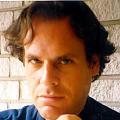Art Review magazine unveiled their Power 100 list at the Frieze Art Fair in London. Damien Hirst, voted number one last year and the cover boy of Art Review's October 2009 issue, plummeted this year to number 48, indicating a possible reaction to the star artist syndrome occasioned by current economic worries. Although artists such as Bruce Nauman (number 10), Jeff Koons (13), Fischli & Weiss (19) and Mike Kelley (20) are highly placed.
 Bruce Nauman
Bruce Nauman
In addition to the expected mega dealers and mega collectors, a number of curators have garnered top power spots, led by omnipresent curator, panelist and art world organizer Hans Ulrich Obrist, the Swiss-born critic and co-director of Exhibitions at the Serpentine Gallery. He is this year's numero uno.
 Hans Ulrich Obrist
Hans Ulrich Obrist
Glenn Lowry, director of MoMA, took second place; he did not even appear in last year's list. Sir Nicholas Serota, director of the Tate, came in third.
Analysis from The Independent indicates:
It is curators rather than artists who are now regarded as the real movers and shakers of the art world.
"The people who are the top are the people who are kind of flexible and are able to cope with a world that is rapidly changing," said Mark Rappolt, editor of Art Review. "This is partly because of the recession, but partly because it was happening anyway, because you need to be flexible to work on a global level."
Other critic/curator/museum types given significant placement include Daniel Birnbaum (4), Anton Vidokle (8), Iwona Blazwick (9), Alfred Pacquement (18), Matthew Higgs (29) and Massimiliano Gioni (50). Glenn Beck comes in at number 100. It's good to know someone has a sense of humor.
The list in full:
1. Hans Ulrich Obrist
2. Glenn D. Lowry
3. Sir Nicholas Serota
4. Daniel Birnbaum
5. Larry Gagosian
6. François Pinault
7. Eli Broad
8. Anton Vidokle, Julieta Aranda & Brian Kuan Wood
9. Iwona Blazwick
10. Bruce Nauman
11. Iwan Wirth
12. David Zwirner
13. Jeff Koons
14. Jay Jopling
15. Marian Goodman
16. Agnes Gund
17. Takashi Murakami
18. Alfred Pacquement
19. Fischli & Weiss
20. Mike Kelley
21. Barbara Gladstone
22. Steven A. Cohen
23. Dominique Lévy & Robert Mnuchin
24. Adam D. Weinberg
25. Marc Glimcher
26. Brett Gorvy & Amy Cappellazzo
27. Tobias Meyer & Cheyenne Westphal
28. Ann Philbin
29. Matthew Higgs
30. Matthew Marks
31. Tim Blum & Jeff Poe
32. Gavin Brown
33. Ralph Rugoff
34. Liam Gillick
35. Anne Pasternak
36. Dakis Joannou
37. John Baldessari
38. Isa Genzken
39. Paul McCarthy
40. Michael Govan
41. Eugenio López
42. Cindy Sherman
43. Ai Weiwei
44. Patricia Phelps de Cisneros
45. Annette Schönholzer & Marc Spiegler
46. Diedrich Diederichsen
47. Richard Prince
48. Damien Hirst
49. Bernard Arnault
50. Massimiliano Gioni
51. Amanda Sharp & Matthew Slotover
52. Joel Wachs
53. Victor Pinchuk
54. Udo Kittelmann
55. Marina Abramovic
56. Michael Ringier
57. Gerhard Richter
58. Richard Serra
59. RoseLee Goldberg
60. Kasper König
61. Roberta Smith
62. Monika Sprüth & Philomene Magers
63. Germano Celant
64. Emmanuel Perrotin
65. Peter Schjeldahl
66. Beatrix Ruf
67. Okwui Enwezor
68. Nicolas Bourriaud
69. Karen & Christian Boros
70. Isabelle Graw
71. Maurizio Cattelan
72. Charles Saatchi
73. Jerry Saltz
74. Jasper Johns
75. Louise Bourgeois
76. Thaddaeus Ropac
77. Mera & Don Rubell
78. Thelma Golden
79. Sarah Morris
80. Carolyn Christov-Bakargiev
81. Anita & Poju Zabludowicz
82. Paul Schimmel
83. Jose, Alberto & David Mugrabi
84. Sadie Coles
85. Daniel Buchholz
86. Victoria Miro
87. Maureen Paley
88. Johann König
89. Nicolai Wallner
90. Maria Lind
91. Massimo De Carlo
92. Mario Cristiani, Lorenzo Fiaschi & Maurizio Rigillo
93. Rirkrit Tiravanija
94. Toby Webster
95. Long March Space
96. Nicholas Logsdail
97. Harry Blain & Graham Southern
98. Claire Hsu
99. Peter Nagy
100. Glenn Beck
The cover of the November 2009 issue of Art Review (which features the Power 100):

The magazine website has a page on the Power 100, with demographic breakdowns and an open comments thread.

Facebook Feedback on the Power 100 posting
I linked this post on my Facebook page and various people offered their input.
Wolfgang Stiller:
Steven Kaplan:
Oliver Wasow:
Steven Kaplan:
Wolfgang Stiller:
Grace Graupe Pillard: